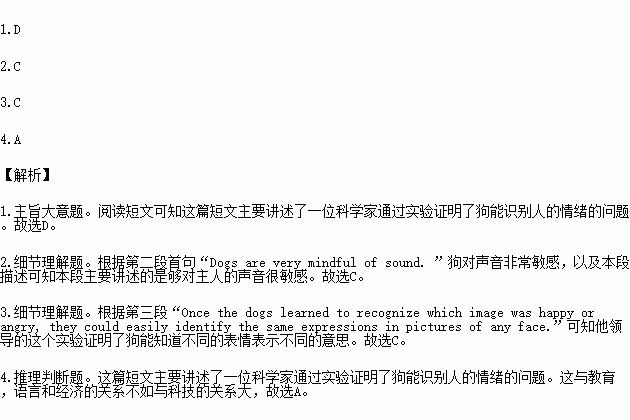题目内容
So you think you know your dog. But how well does your dog know you? She probably recognizes you when she sees you. But can a dog tell by simply looking at you whether you have a happy or an angry expression on your face? Researchers in Austria have taught pet dogs to know the difference.
Dogs are very mindful of sound. When dog owners shout or speak in a strong, harsh(刺耳的) voice, dogs often act guilty and quietly move away from the area. Researchers have found that dogs can look at our faces, and tell the difference between a smile and a frown. The animals were able to recognize a look of approval from one of disapproval.
Researchers performed a series of experiments. They taught dogs to recognize facial expressions. They showed the dogs two pictures of either the upper of lower half of a person’s face. On one picture, the person looked happy. The other appeared angry. The dogs were then shown images of the eyes or mouths of people they had never seen before. They were also shown the left half of the faces used in training. Once the dogs learned to recognize which image was happy or angry, they could easily identify the same expressions in pictures of any face.
Corsin Muller, who led the study, says future studies will try to show whether dogs can learn the meaning of facial expressions—for example, whether a frown shows that someone is angry. “What we can say with our study is that they can tell these ones are different. But what we cannot be sure of at this point is what exact meaning they are associating with these different expressions.”
“Of course it seems likely that they would associate (联系)some positive meanings with the smiley face and they would associate some rather negative meanings with the angry face. But what exactly they are associating with these expressions we cannot know at this point.” Corsin says.
1.The passage tells us mainly about _____________.
A. how dogs communicate with each other
B. What are the best ways to train our dogs
C. Why it’s necessary to know our pet dogs well
D. whether dogs can recognize our facial expressions
2.We know from the second paragraph that a dog_____________.
A. pays little attention to its owner’s looks
B. has to be trained to recognize our voices
C. is very sensitive to its owner’s voices
D. will feel guilty if their owner frowns
3.According to Corsin Muller, it’s been proven that dogs know_____________.
A. the exact meaning of a frown
B. a frown is an angry expression
C. human looks carry different meanings
D. a smiley face may have negative meanings
4.In which part of a website does the text probably appear?
A. Technology. B. Education.
C. Language. D. Economics.


 ? I’ll give each of them only $ 1 and keep the $ 2 left to myself. The men will be happy to get anything back, and I can also make some money that way. After all, Mr. Black will never know anything about it.” So, the assistant returned only $1 to each of the three men.
? I’ll give each of them only $ 1 and keep the $ 2 left to myself. The men will be happy to get anything back, and I can also make some money that way. After all, Mr. Black will never know anything about it.” So, the assistant returned only $1 to each of the three men. ager did not know how to make money, but the assistant did.
ager did not know how to make money, but the assistant did.